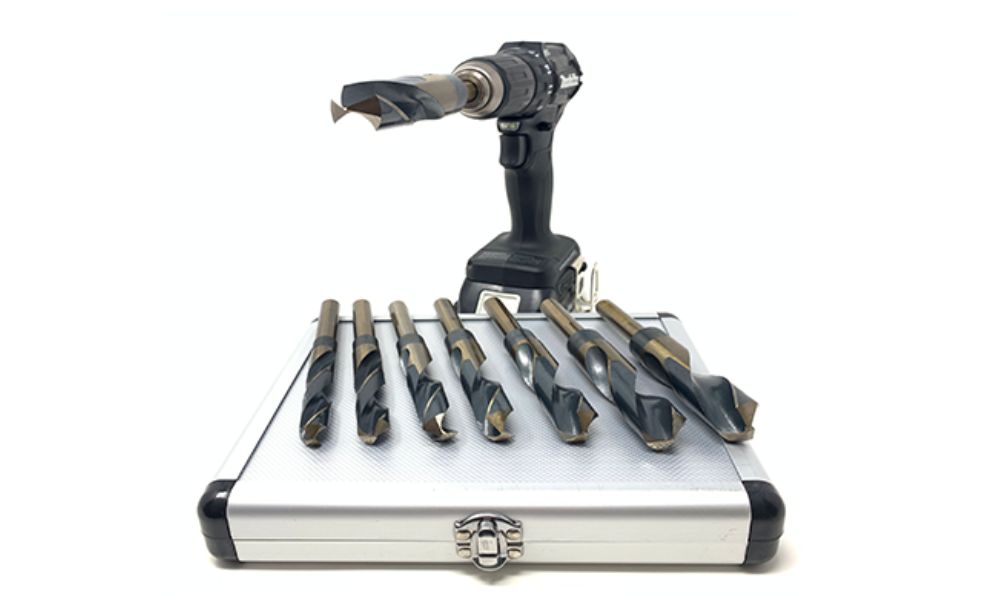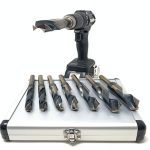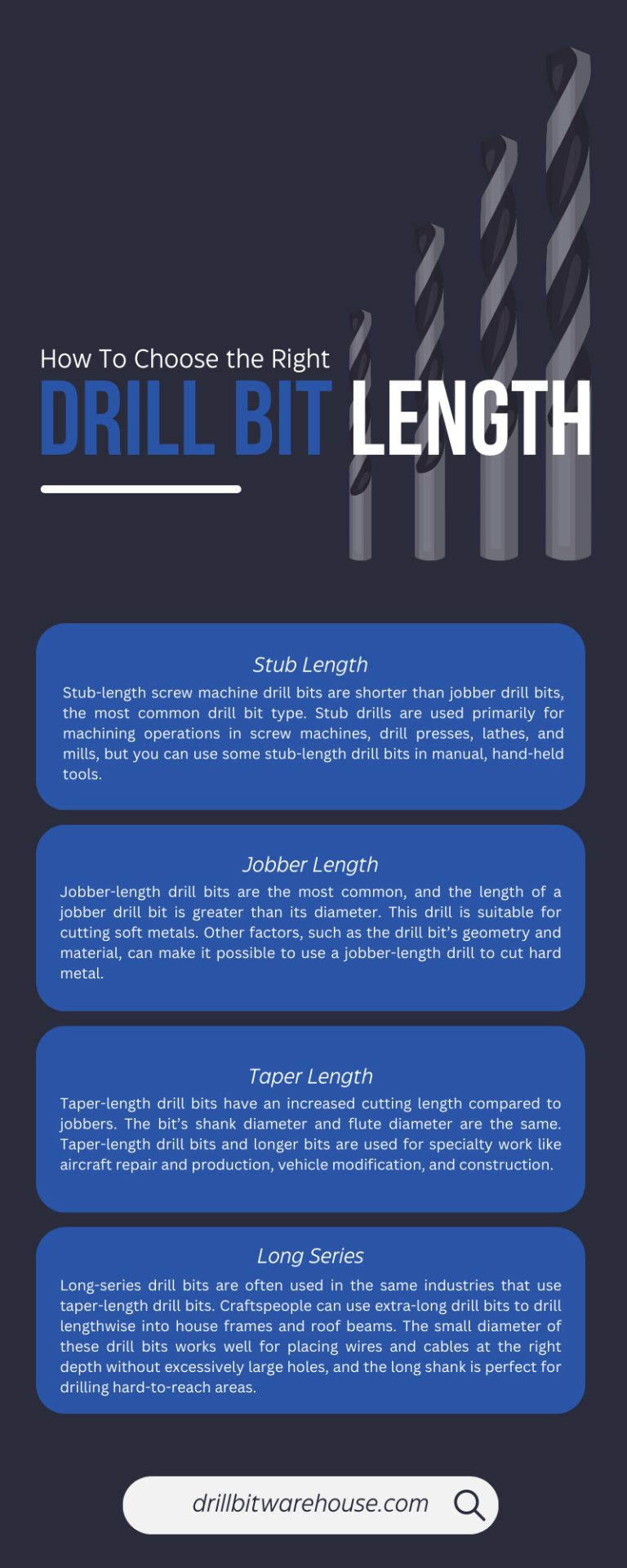The length of a drill bit determines how deeply you can drill a hole. The length also affects the bit’s rigidity and cutting accuracy. Longer bits can drill deeper holes, but the drill can wander and create an inaccurate hole because the long bits are more flexible. Continue reading to learn how to choose the right drill bit length.
Standard Twist Drill Bit Lengths
Twist drill bits are available in standard lengths, which you can compare below. Longer drill bits can be more challenging to work with. Additionally, the greater the drill bit’s length compared to its diameter, the more technical skill it takes to drill an accurate hole.
Stub Length
Stub-length screw machine drill bits are shorter than jobber drill bits, the most common drill bit type. Stub drills are used primarily for machining operations in screw machines, drill presses, lathes, and mills, but you can use some stub-length drill bits in manual, hand-held tools.
The shorter length makes stub-length twist bits very rigid, which helps them drill straighter holes than jobber twist bits. They’re typically limited to drilling about an inch deep into the workpiece material. You’ll find stub-length cutting tools in manufacturing settings and machine shops.
Jobber Length
Jobber-length drill bits are the most common, and the length of a jobber drill bit is greater than its diameter. This drill is suitable for cutting soft metals. Other factors, such as the drill bit’s geometry and material, can make it possible to use a jobber-length drill to cut hard metal.
Taper Length
Taper-length drill bits have an increased cutting length compared to jobbers. The bit’s shank diameter and flute diameter are the same. Taper-length drill bits and longer bits are used for specialty work like aircraft repair and production, vehicle modification, and construction.
Long Series
The diameter-to-length ratio of a standard drill bit is usually between 1:1 and 1:10, but long series bits, sometimes called aircraft-length, have a much higher ratio. The higher the ratio, the more technically challenging it is to produce good work.
Long-series drill bits are often used in the same industries that use taper-length drill bits. Craftspeople can use extra-long drill bits to drill lengthwise into house frames and roof beams. The small diameter of these drill bits works well for placing wires and cables at the right depth without excessively large holes, and the long shank is perfect for drilling hard-to-reach areas.
Drill Bit Geometry
Length is not the sole determiner of a drill bit’s strengths and limitations. Another important consideration when choosing the right drill bit length is the tool’s geometry. Geometries of drill bits include the point angle, helix angle, and lip relief angle.
Point Angle
The point angle is the angle of the cutting head at the bit tip. The two most common point angles are 118 and 135 degrees.
The 118-degree angle is less steep, less pointed, and has a smaller chisel; it cuts less aggressively than a 135-degree bit. The 118-degree point angle becomes dull more quickly when used to cut harder materials, so the 135-degree point angle is typically used for drilling into harder materials due to its sharper point.
Helix Angle
The helix angle is the angle formed between the centerline running the length of the bit and the line of the flute. Most twist drills have a helix angle of about 30 degrees.
A high helix angle, typically 40 degrees or more, rotates around the tool faster than a low helix angle. This characteristic is why high helix drill bits are sometimes called fast spiral angle drills. Generally, the deeper the hole, the higher the helix angle required for effective swarf removal.
Lip Relief Angle
The lip relief angle, also called the lip clearance angle, is created by the cutting lip with the drill bit’s axis. The lip angle determines the force required to start and continue cutting, the swarf’s shape and size, and the hole’s accuracy and finish.
A larger angle is typically used for drilling harder materials like stainless steel. Standard lip angles for twist drill bits are usually between 118 and 135 degrees, but specialized drill bits can have different lip angles.
Drill Bit Material
The shorter the drill bit, the more rigid it stays and the easier it is to drill an accurate hole. But another drill bit quality that contributes to its suitability is the material it’s made from. The most common twist drill bit materials are high-speed steel, cobalt steel, carbide, and titanium.
High-speed steel (HSS) drill bits are made from steel, tungsten, and other metals. Cobalt steel drill bits contain more cobalt than other bits, making them more durable and heat resistant. Carbide drill bits have a combination of tungsten carbide and cobalt; they’re extremely hard and can drill through tough materials like cast iron.
Titanium drill bits do not contain titanium throughout the drill bit. Instead, they are typically made from HSS or cobalt steel and have a thin titanium nitride coating. The coating improves wearability and reduces friction while drilling.
Once you’ve chosen the appropriate drill bit length for the job, compare drill bit materials to get the best results. A 12-inch HSS aircraft extension bit can drill holes in places that are normally hard to access. But a 12-inch cobalt bit is a super high-grade, premium bit that can cut through weld seams and most hardened metals, including bronze and titanium.
Protective Techniques
To avoid breaking a long drill bit, drill a pilot hole with a shorter bit. Then continue drilling with the extra-long drill bit.
Always try to use the shortest drill bit possible to avoid breakage and to make an accurate hole. It can sometimes be better to use a short bit to drill on either side of a workpiece than to drill once all the way through with a long bit.
Choosing the right drill bit is key to starting a smooth and accurate project. Use suitable lubricating and cutting oils when possible to improve drill bit performance and extend the tool’s cutting life.
Shop with Drill Bit Warehouse for high-speed bit sets. We carry lengths from 1/8 inch to 12 inches so you can always find what you need. Shop with us today for essential tools for drilling metal.





